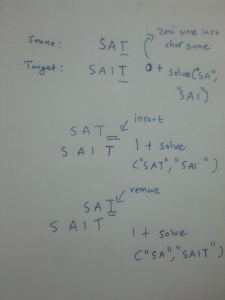http://www.spoj.com/problems/DSUBSEQ/
Consider the string “ABCD”
Let dp[i] = { number of subsequences possible from string[1…i]}
Note : we are considering 1 based string array
what are all the possible subsequences
dp[0] = 1 { }
dp[1]= 2 { } ,A
dp[2] = 4 { } ,A ,B ,AB
dp[3] = 8 { } ,A ,B ,AB ,C ,AC,BC,ABC
dp[4] = 16 { } ,A ,B ,AB ,C ,AC,BC,ABC,D,AD,BD,ABD,CD,ACD,BCD ,ABCD
So do we get some kind of pattern ?
yes!
dp[i]= dp[i-1]*2
(sum of all subseq till string[1…i-1] + sum of subseq till string[1…i-1] concatenated with character string[i])
There one more case we have to consider
if we have duplicate characters in the string then our subsequence will also be duplicated
To prevent that have a last[ ] array to store position of string[i] which occured before
last[string[i]]= last occurence of string[i]
substract subsequence count occured till position (last[string[i]]-1) since it is repeated again
so the correct recursion rule is
dp[i]=dp[i-1]*2;
if(last[string[i]]>0)
dp[i]=(dp[i]-dp[last[string[i]]-1]);
